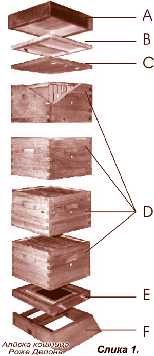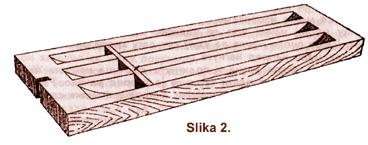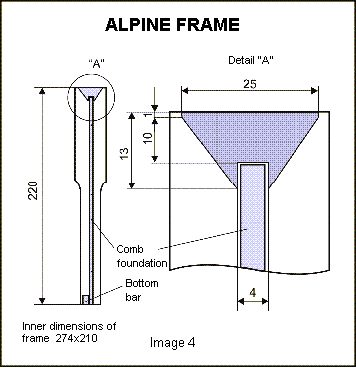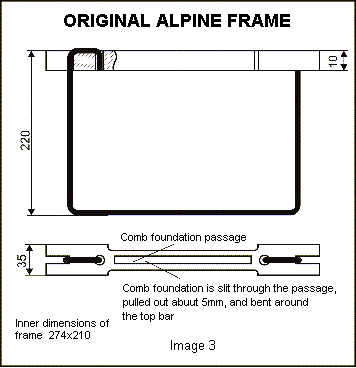Alpine hive
(Part 1)
Slobodan é. Janković
Serbia
By all of its characteristics, the alpine hive, constructed by Roger Delon can be considered as a new type of hive.
The constructor Roger Delon keeps more then 1000 of these hives on several locations on the Alps in the area of 120 km in diameter. He does all the work on these apiaries himself.
As the constructor claims, the average season honey crop per a hive exceeds the honey crop of more frequent hives, especially in seasons with not very favorable honey crop. He states the example of a beekeeper in Carpathian Mountains who in 1988 got 2 kg of honey per hive in his 50 Dadant hives, while his Alpine hives gave him 22 kg per hive. Besides, as he claims, in the alpine hives bees drew three boxes of comb (24 frames Ė the surface of comb on one frame equals Ĺ of Dadant comb foundation surface) while in Dadant hives not a single foundation was drawn.
My experience confirms the advantages of this hive type in conditions of low honeyflow. However, when there is a lot of nectar in nature, one must always be on the apiary to prevent swarming, since the supers are quickly filled with honey, and the hive, including stand and six boxes becomes very high. In such circumstances, special measures must be taken to ensure the hives against overturning, since the base surface is very small. The hives can be secured in different ways.
Roger Delon solves the instability problem by putting 4 hives on a mutual hive stand, under one mutual roof, and by fastening small beams which secure the hives to two 200x200x400 mm concrete bricks, which are partly buried into the ground.
Small dimensions of this hive are an important advantage, because one box full of honey weighs about 16 kg, 11 kg of which is honey. Bees build comb and fill it with honey very quickly. Honey ripens very quickly too. The size of frames results in the better stability of comb, so even when extracted at greater speed comb is never damaged.
This hiveís dimensions are very favorable for relocating the hives. Bees overwinter miraculously well. After all, the proportions of the hive are similar to those of natural habitats of bees in tree holes. Besides, as a result of the small size, more alpine than other hives can be put on the same surface.
|
On image 1 we see the constituents of alpine hive with some details of construction slightly modified |

|
 |
| Image 2 | Image 2 |
A typical hive consists of:
- Roof (A) with external dimensions 400x400x80 mm. Itís a good solution to use a sandwich made of two hardboards and 20 mm Styrofoam in the middle as a roof board instead of a plank. The roof is coated with aluminum sheets which can be obtained as recluse in offset printing process at printing factories.
- Ventilation mesh (B) with external dimensions equal to those of the boxes and 20 mm height
- Top feeder (C) on image 2, which is at the same time the inner cover, consists of three wooden elements 100x300x25 mm, built in a frame made of 22x22 mm bars dimensions of which are the same as those of the boxes. Each element has an opening carved at front 10 mm wide and 20 mm long which serves as a passage for bees to sugar syrup which is poured in 22x240x20 mm grooves (three on each element). During winter period honey / sugar cake covered with thin plastic foil can be pressed into these grooves, the cover is then turned around so that the food gets right above the top bars. Instead of this inner cover it is possible to use the standard one with an opening for top feeder.
- 4 boxes (D) with internal dimensions 298x298 mm if the original frame (image 3) is used, or 306 mm if the frame from the image 4 is used.
- Bottom board (E) with pollen collector activated by pulling the frame which carries collectorís grating towards the entrance which makes bees enter the hive through the grating.
- American hive stand (F)
- It is written in the translation I have that one of the constituents of this hive is a cassette which is used for making queen cells and collecting royal jelly. No dimensions are mentioned and there are no pictures (there are no pictures in the whole text) but I suppose that it is a ring 70-80 mm high.
- The frames of this hive are specific. They can be built in two ways (image 3 and 4). The original version is on image 3, and modified (by Koste Velcev, a Bulgarian beekeeper if Iím not mistaken) on image 4. The original frame has a wooden top bar and other bars made of 3-4 mm wire which is about 750 mm long when unbent. The modified variety on image 4 is completely made of wood and its construction reduces vertical distance between two frames to only 10-11 mm. By putting every box 90 degrees towards the lower one (the way I do), frames are crossed and bees will build little comb bridges in the lower part of the frame towards every frame of the lower box and thus ensure easy transfer from one box to another, and from one frame of one box to any frame of the other box.
|
|

|
|
|
